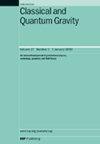规范理论中的s代数:扭曲、时空和全息透视
IF 3.7
3区 物理与天体物理
Q2 ASTRONOMY & ASTROPHYSICS
引用次数: 0
摘要
天体s -代数产生于对天体全息术中杨-米尔斯s -矩阵共线极限的重新解释。随后,通过在零无穷远处定义的Yang-Mills辐射相空间中定义的渐近电荷方面和在扭转空间中的扭曲全息顶点代数构造来表示它。本文首先通过守恒量和相关流的层次,将其与传统的自对偶Yang-Mills理论的对称代数识别为可积系统;自对偶相空间可以正则地等同于零无穷远处的满杨-米尔斯相空间。我们从扭转或空间作用中导出了相关的正则发生器,确定了与两个胶子螺旋度相对应的两个无限电荷塔。这些表达式使用扭转或积分公式转换为零无穷处的时空数据。在类空间无穷大处检查电荷代数揭示了在扭曲全息背景下研究的顶点代数。我们的讨论直接延伸到自对偶引力的天体对称性。这一分析为天体对称性提供了一个统一的框架,连接了扭曲、时空和全息方法,并最终形成了自对偶规范理论的非线性外推字典。本文章由计算机程序翻译,如有差异,请以英文原文为准。
S-algebra in gauge theory: twistor, spacetime and holographic perspectives
The celestial S-algebra arose from a reinterpretation of collinear limits of the Yang–Mills S-matrix as OPEs in celestial holography. It was subsequently represented via asymptotic charge aspects defined in the Yang–Mills radiative phase space defined at null infinity on the one hand, and via a twisted holography vertex algebra construction in twistor space on the other. Here we first identify it with the traditional symmetry algebra of self-dual Yang–Mills theory as an integrable system via its hierarchies of conserved quantities and associated flows; the self-dual phase space can be canonically identified with that of full Yang–Mills at null infinity . We derive the associated canonical generators from the twistor space action, identifying two infinite towers of charges corresponding to the two gluon helicities. These expressions are translated into spacetime data at null infinity using twistor integral formulae. Examining the charge algebra at spacelike infinity reveals the vertex algebras studied in the context of twisted holography. Our discussion extends directly to the celestial symmetries of self-dual gravity. This analysis provides a unified framework for celestial symmetries, connecting twistor, spacetime, and holographic approaches and culminating in a nonlinear extrapolate dictionary for self-dual gauge theory.
求助全文
通过发布文献求助,成功后即可免费获取论文全文。
去求助
来源期刊

Classical and Quantum Gravity
物理-天文与天体物理
CiteScore
7.00
自引率
8.60%
发文量
301
审稿时长
2-4 weeks
期刊介绍:
Classical and Quantum Gravity is an established journal for physicists, mathematicians and cosmologists in the fields of gravitation and the theory of spacetime. The journal is now the acknowledged world leader in classical relativity and all areas of quantum gravity.
 求助内容:
求助内容: 应助结果提醒方式:
应助结果提醒方式:


